Chopsticks are an extremely important tool in Japanese culinary culture.
Using chopsticks properly not only helps you enjoy Japanese food more deliciously, but also helps people eating together feel more comfortable.
In this article, I will introduce in detail how Japanese people use chopsticks and 15 things to absolutely avoid when using chopsticks in Japan.
- How to use chopsticks in Japan
- 15 taboos when using chopsticks in Japan
- Do not stick chopsticks into the rice bowl
- Do not pass food from chopsticks to chopsticks
- Do not use chopsticks to skewer food
- Do not use personal chopsticks to eat shared dishes
- Do not hold chopsticks when inviting to eat
- Do not rest your chopsticks across the rim of the bowl while eating
- Do not move chopsticks while food is dripping
- Do not use chopsticks to pull the bowl towards you
- Do not wave your chopsticks back and forth when choosing food
- Do not use chopsticks to find a food by rummaging in dish
- Do not lick chopsticks
- Do not use chopsticks to point at others
- Do not align chopsticks by tapping on the table
- Do not use chopsticks to tear food
- Do not hold out one’s bowl for more while still holding chopsticks
How to use chopsticks in Japan
How to hold chopsticks is both easy to eat and aesthetically pleasing
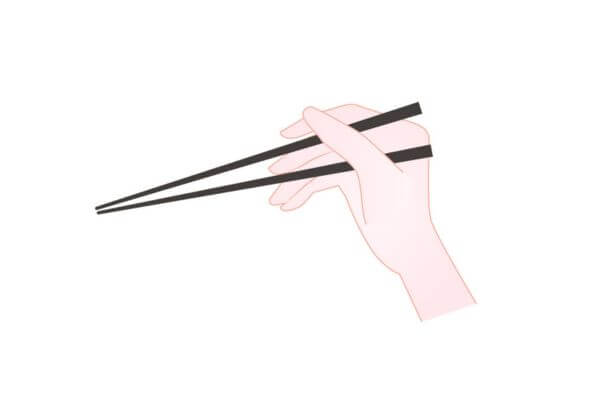
Hold the chopsticks about two-thirds of the way from the tip. Hold the upper chopstick like you’re holding a pencil and place the lower chopstick between your middle and ring fingers.
When picking up items, use your index finger, middle finger and thumb to move the upper chopsticks but not the lower chopsticks.
By opening and closing the tips of the chopsticks, you can pick up items of any size with ease.
How to pick up chopsticks
How to pick up chopsticks when both hands are free
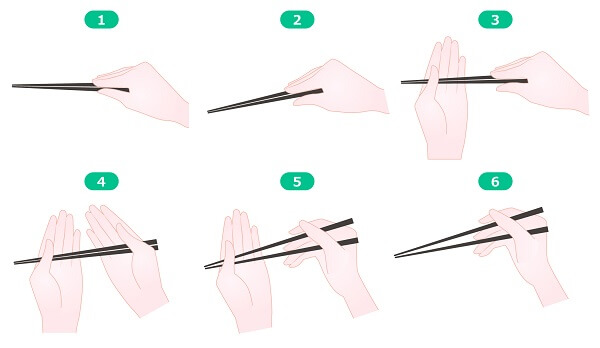
Pinch the fingers of your dominant hand together to lift the chopsticks, combine with your other hand to make the two ends of the chopsticks equal, and finally hold the chopsticks with your dominant hand.
How to pick up chopsticks when one hand is holding the bowl
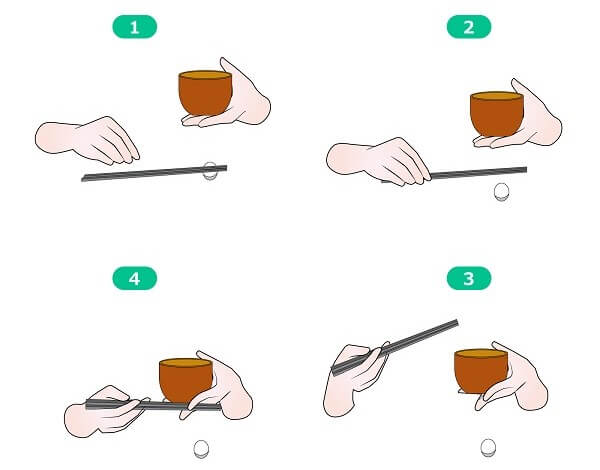
Pinch the fingers of your dominant hand together to lift the chopsticks, slide the chopsticks between the index and middle fingers of the other hand to make the two ends of the chopsticks equal, and finally hold the chopsticks with your dominant hand.
How to use disposable chopsticks
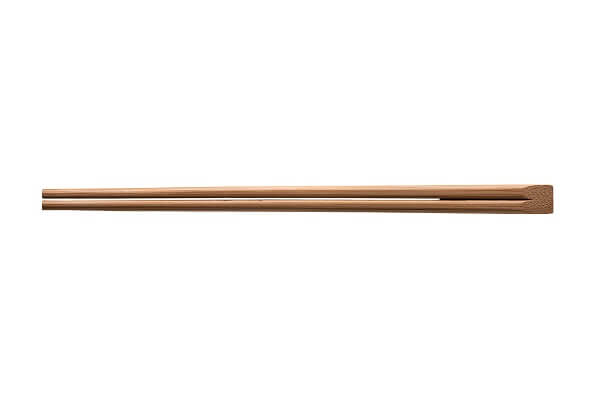
Disposable chopsticks (Waribashi) are chopsticks made from wood or bamboo, retaining the natural color of the material and without patterns.
Disposable chopsticks are widely used in Japan, from convenience stores, Ramen noodle shops or even some high-end Washoku restaurants.
There are two types of disposable chopsticks, one is pre-separated chopsticks, the other is unseparated chopsticks.
In case chopsticks have not been separated, bring the chopsticks to the top of your thigh, place the chopsticks horizontally and then separate them.
Sometimes there will be some wood chips left on the chopsticks. Instead of rubbing two chopsticks together to let the wood chips fall out, use your hands to pick up those wood chips.
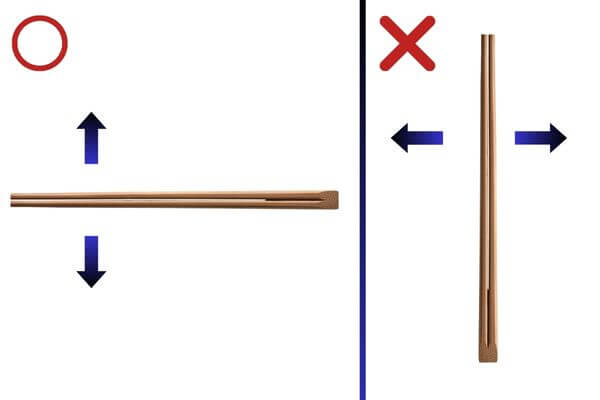
You should not place your chopsticks vertically and then separate them because your elbow may bump into the person next to you.
After finishing your meal, you may want to break your chopsticks in half to let the staff know that these are used chopsticks, but this action is considered rude in Japan, so don’t do it.
You can put the chopsticks back in the chopsticks bag and fold 1/3 of the bag as a way to signal: “These are used chopsticks.”, or simply leave the chopsticks back on the tray.
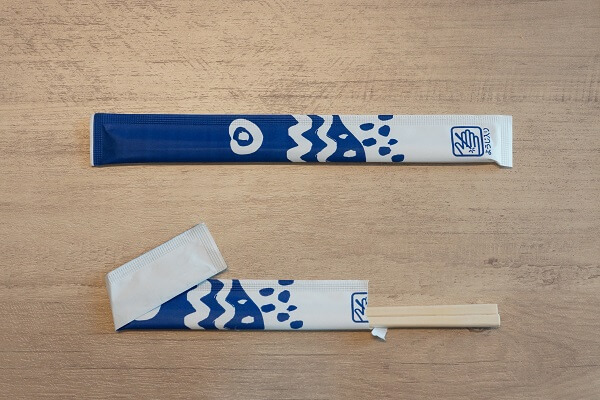
How to use chopsticks when eating soup
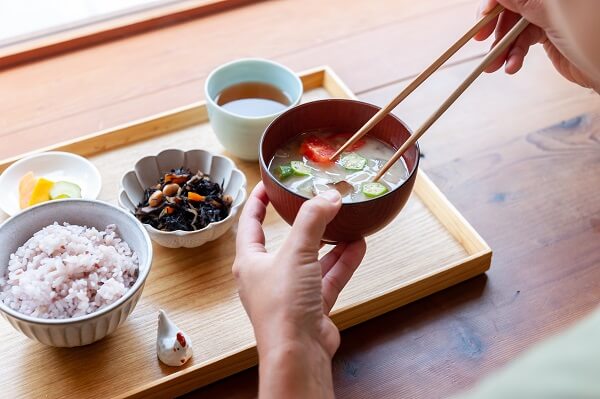
In Japan, soups are eaten with chopsticks.
First, pick up your bowl of soup.
When you want to eat the ingredients in the soup, pick them up as usual.
When you just want to sip the soup, use chopsticks to keep the ingredients in the bowl.
How to use chopsticks when eating fish
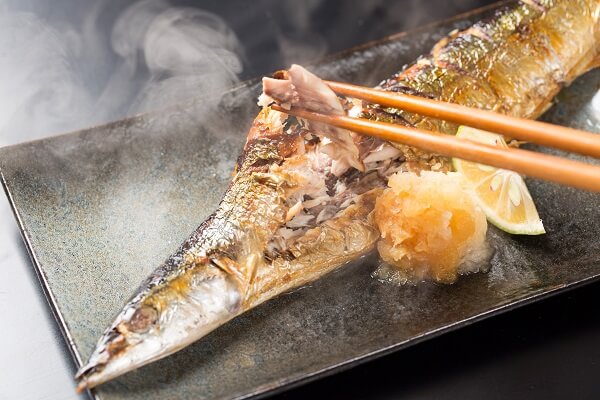
After eating the fish meat above, use chopsticks to separate the fish bones and place them in a corner of the plate, then eat the fish meat below.
You should not turn the fish upside down to eat because this is considered impolite in Japan, especially in high-end restaurants.
15 taboos when using chopsticks in Japan
In the next part, I will introduce 15 taboos when using chopsticks that many people often have.
You may be familiar with using chopsticks, but there are basic Japanese rules that you should remember to show respect for those who make the food, as well as create a comfortable feeling for people eating together.
Do not stick chopsticks into the rice bowl
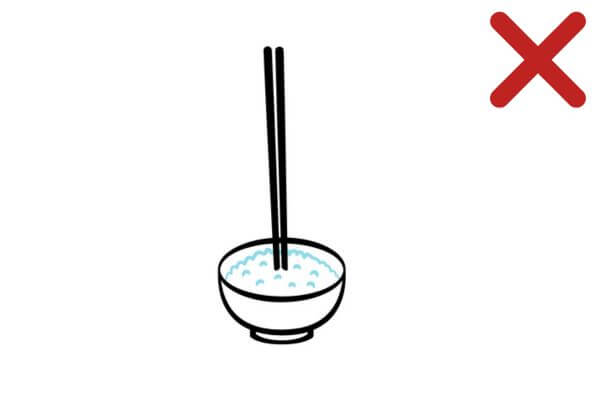
The act of “sticking chopsticks into a bowl of rice” in Japanese is called “Tate-bashi” (立て箸).
This is a great taboo action because it reminds people of offering food to the deceased.
Do not pass food from chopsticks to chopsticks
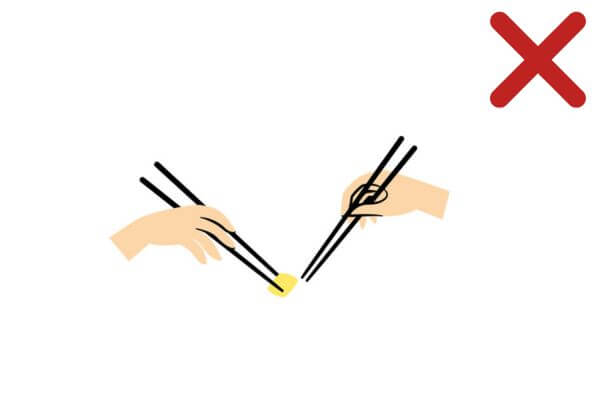
The act of “passing food from chopsticks to chopsticks” in Japanese is called “Hiroi-bashi” (拾い箸).
You absolutely need to avoid it because this action reminds people of picking up the remains of the dead after cremation.
If you want to share food with others, put the food on a plate and give it to them.
Do not use chopsticks to skewer food
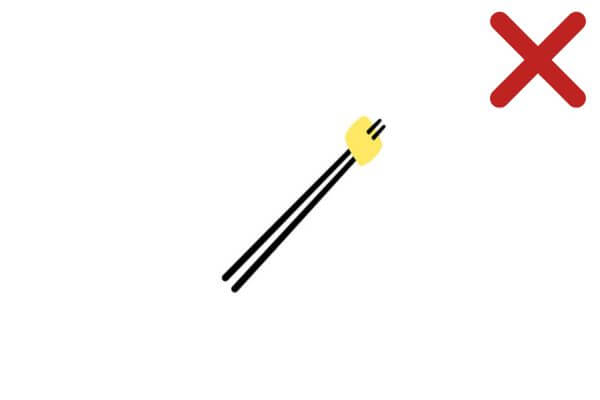
The act of “sticking chopsticks into food” in Japanese is called “Sashi-bashi” (刺し箸).
For round dishes like potato, you can skewer one chopstick into the potato, then hold it with the other to make it easier to pick up.
Do not use personal chopsticks to eat shared dishes
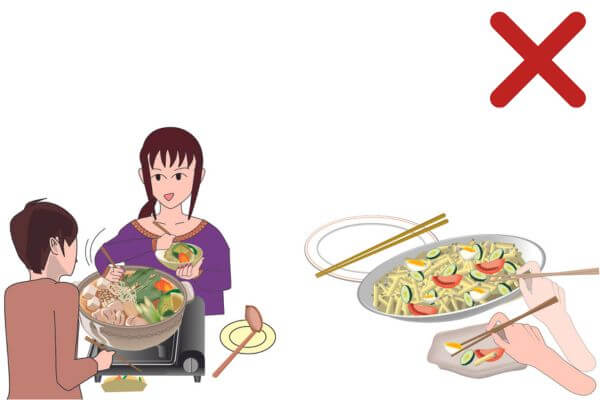
The act of “using personal chopsticks to eat shared dishes” in Japanese is called “Jika-bashi” (直箸).
Needless to say, this is not only unhygienic but also makes people at the table feel uncomfortable. Some of you will come up with the solution of turning the chopsticks to pick it up, but this is also an unhygienic action, so don’t do it.
In Japan, for shared dishes, the staff will serve you with a pair of long chopsticks called “Toribashi” for you to pick up food on your plate. Please use Toribashi chopsticks to ensure hygiene when eating with others.
Do not hold chopsticks when inviting to eat
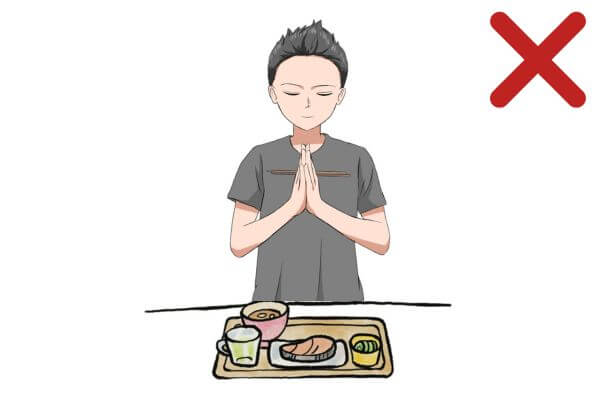
The act of “holding chopsticks when offering rice” in Japanese is called “Ogami-bashi” (拝み箸).
In Japan, people say “Itadakimasu” (I humble receive this food) at the beginning of a meal and “Gochisōsama deshita” (Thank you for the food) at the end of the meal.
Some people have a habit of holding chopsticks and clasping their hands while saying these two sentences. However, this is a wrong action in Japanese chopsticks culture so you should avoid it.
Remember the correct order that we should do is to clasp our hands and say “Itadakimasu”, then pick up our chopsticks and start eating. After finishing eating, put down your chopsticks, clasp your hands and say “Gochisōsama deshita”.
Do not rest your chopsticks across the rim of the bowl while eating
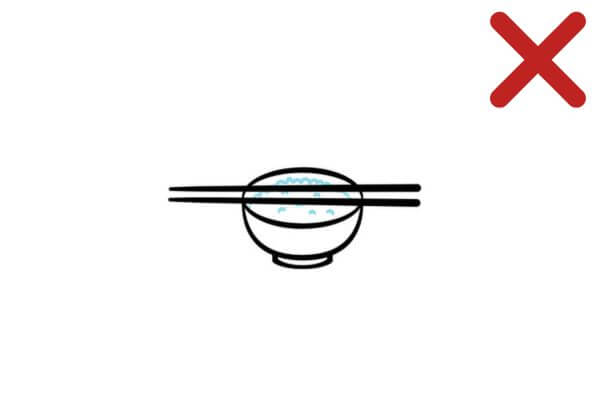
The act of “putting chopsticks across the rim of the bowl while eating” is called “Watashi-bashi” (渡し箸) in Japanese.
Because this action implies: “I don’t eat anymore.” so while you’re still having a meal, don’t do it.
Do not move chopsticks while food is dripping
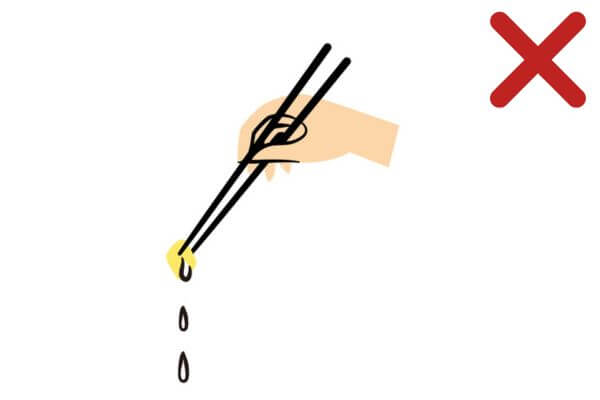
The act of “moving chopsticks while food drips” in Japanese is called “Namida-bashi” (涙箸), which usually happens when you pick up food from a bowl of soup or dishes with a lot of sauce.
To avoid this situation, hold up your bowl or use a plate to prop while eating.
Do not use chopsticks to pull the bowl towards you
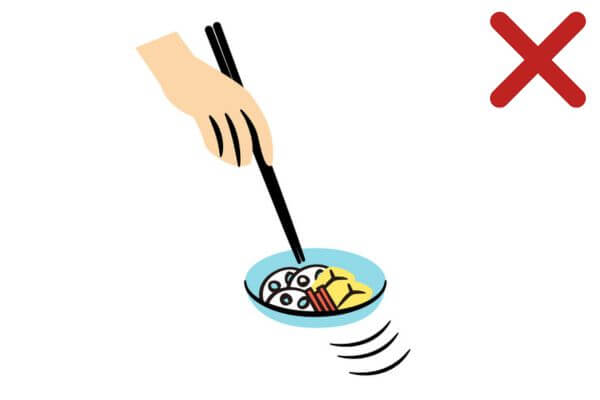
The act of “using chopsticks to pull the bowl towards you” in Japanese is called “Yose-bashi” (寄せ箸).
Please use your hands to hold the bowl to be more polite.
Do not wave your chopsticks back and forth when choosing food
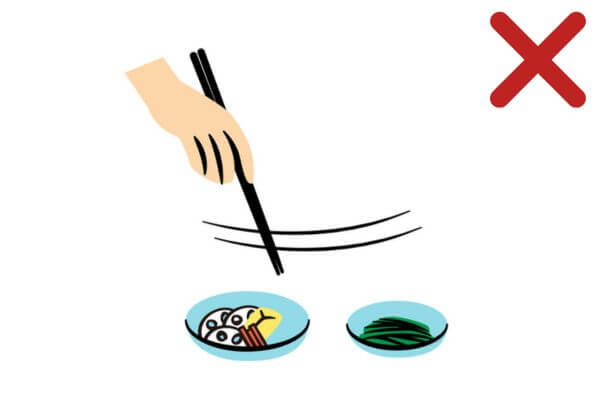
The act of “waving chopsticks back and forth when choosing food” in Japanese is called “Mayoi-bashi” (迷い箸).
You may be wondering, but avoid waving your chopsticks back and forth, as this can be considered impolite in Japan.
Do not use chopsticks to find a food by rummaging in dish
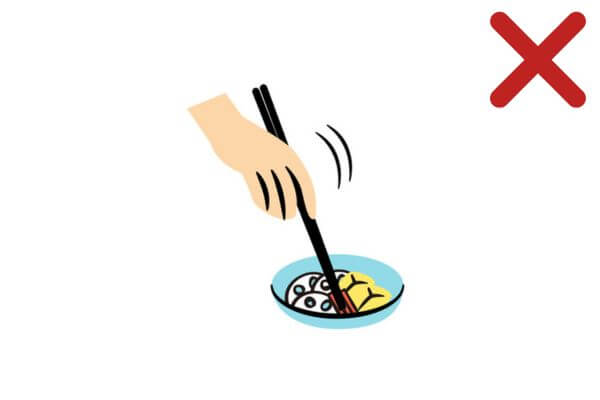
The act of “using chopsticks to find a food by rummaging in dish” in Japanese is called “Saguri-bashi” (探り箸).
When you are served a hot pot full of food or a bowl of Donburi filled with seafood, you will probably want to know what ingredients are inside. I understand the feeling of wanting to use chopsticks to find your favorite ingredients, but this action is not polite so it’s best to avoid it.
Do not lick chopsticks
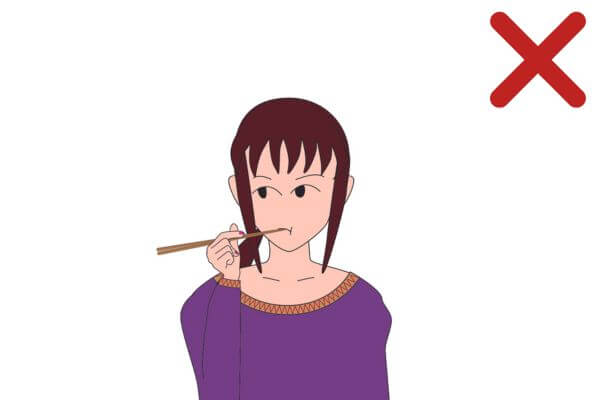
The act of “licking chopsticks” in Japanese is called “Neburi-bashi” (ねぶり箸).
This action is not only unsanitary but also considered disrespectful to those around you, so you should avoid it.
Do not use chopsticks to point at others
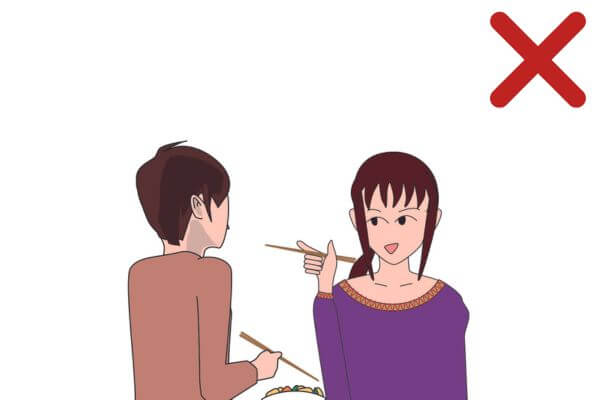
The act of “pointing at someone with chopsticks” in Japanese is called “Furiage-bashi” (振り上げ箸).
No one will feel comfortable being pointed at, so please pay attention to avoid being rude.
Do not align chopsticks by tapping on the table
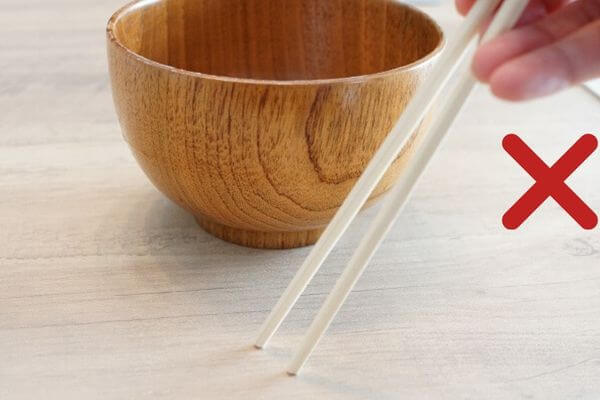
The act of “aligning chopsticks by tapping on the table” in Japanese is called “Soroe-bashi” (揃え箸).
Use your hand to align the tips of your chopsticks and not tap your chopsticks on the table or dishes, because it will be considered impolite.
Do not use chopsticks to tear food
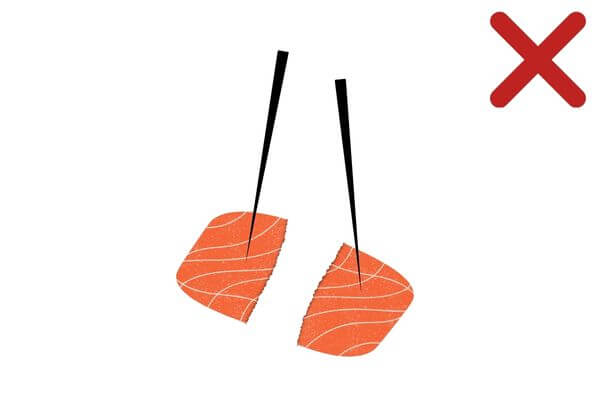
The act of “using chopsticks to tear food” in Japanese is called “Chigiri-bashi” (ちぎり箸).
If it difficult to eat because the dish is too large, you can ask the staff to cut it into small pieces rather than using chopsticks to tear the food apart.
Do not hold out one’s bowl for more while still holding chopsticks
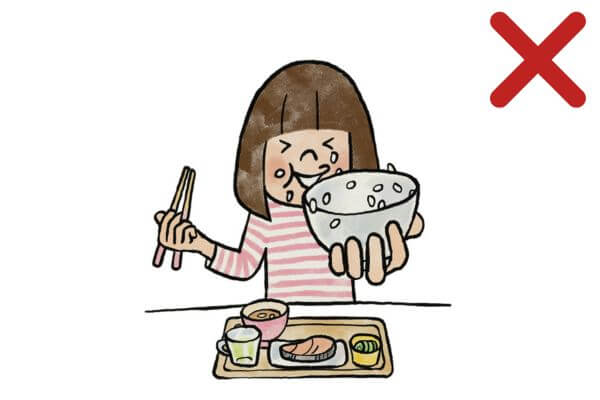
The act of “holding out one’s bowl for more while still holding chopsticks” in Japanese is called “Uke-bashi” (受け箸).
If you want to ask for more rice, put down your chopsticks first and then give the bowl to the restaurant staff.
Conclusion
To fully experience Japanese cuisine, in addition to being proficient in using chopsticks, using chopsticks properly is equally important.
Are you placing disposable chopsticks vertically and then separating them?
When eating with friends or colleagues, do you use personal chopsticks to eat shared dishes?
When eating dishes with many ingredients like hot pot, do you use chopsticks to focus on finding your favorite dish?
Hopefully this article will help you confirm the correct way to use chopsticks, so you can enjoy Japanese food better and create a cosy atmosphere in restaurants.

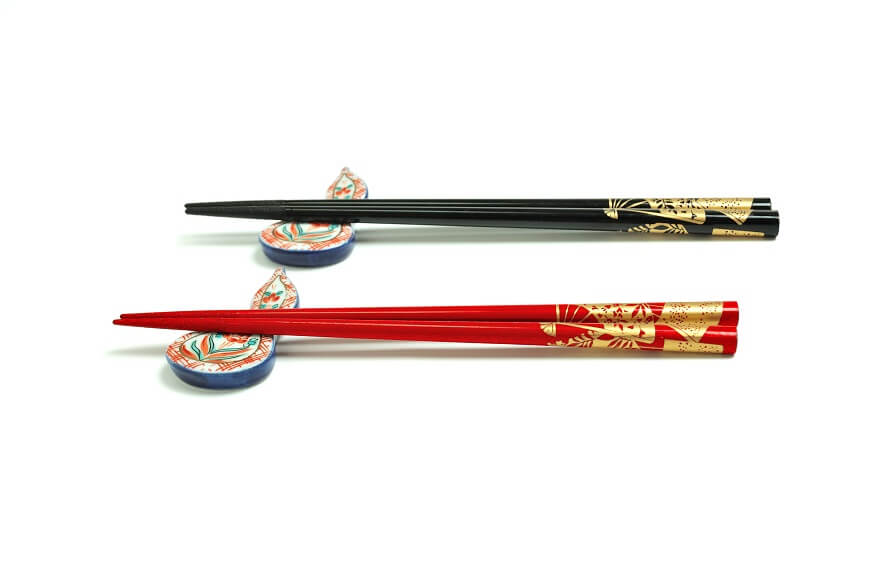
Comment